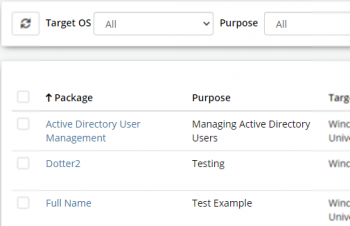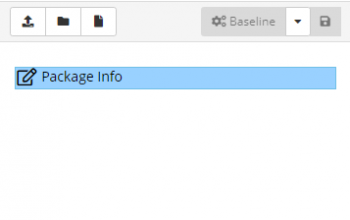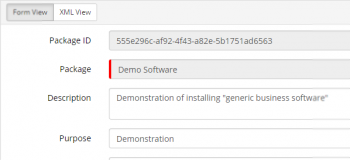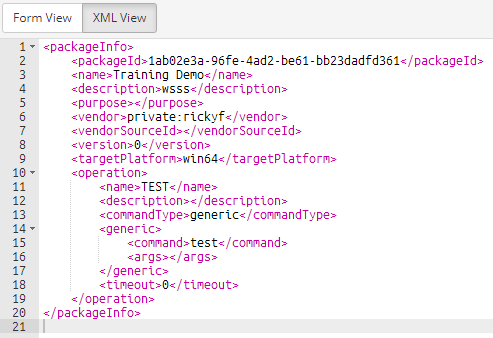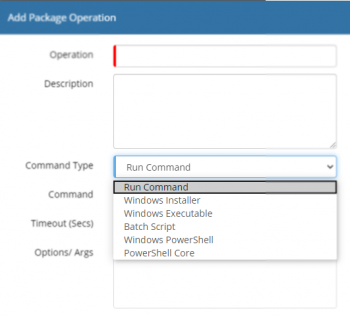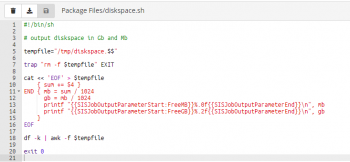Difference between revisions of "Package Creator"
| Line 20: | Line 20: | ||
{{Bullet1|Purpose|Dynamic list populated from the Purpose field of entriies in the list}} | {{Bullet1|Purpose|Dynamic list populated from the Purpose field of entriies in the list}} | ||
{{Bullet1|Filter by package|Free text filter on Package}} | {{Bullet1|Filter by package|Free text filter on Package}} | ||
| − | {{Bullet1|[[#Creating and Editing a Package| | + | {{Bullet1|[[#Creating and Editing a Package|Create a Package]]|Create an IT Automation Package}} |
|style="width:500px| | |style="width:500px| | ||
{{Bullet1|Delete|Delete selected Package(s)}} | {{Bullet1|Delete|Delete selected Package(s)}} | ||
Revision as of 10:18, 6 January 2021
| Home > Administration > ITOM > Package Creator | Index |
IntroductionThe Package Creator allows a user to create Operations within Packages with the necessary programming background and ability. A Package consists of a single Package Info file and with additional resource files where required. The info file contains all the details regarding operations and all parameters that may be necessary. Although it is possible to create a Package manually, a form-based editor is provided to simplify the process to upload and organise resources. These files are used to provide or support a package's operations a can be a combination of; for example; one or more scripts and other filetypes. In addition to uploading files, an interface is also provided to allow various file types to be created via a browser-based editor. |
|
Toolbar
- Refresh
- Target OS
- Operating System that the package was designed for execution
- Windows 32/64-bit
- Apple macOS
- Generic Linux
- Purpose
- Dynamic list populated from the Purpose field of entriies in the list
- Filter by package
- Free text filter on Package
-
- Create an IT Automation Package
- Delete
- Delete selected Package(s)
Package Creator List
- Package
- Unique name given to the Package
- Purpose
- Summary of the intended use of the package
- Target OS
- Operating System that the package was designed for execution
- Published
- Late Published version of the packacge
- Created On
- Date that the package was created
- Created By
- The account used to create the package
- Last Updated On
- Date the package was last updated
- Last Updated By
- The account last used to update the package
Creating and Editing a Package
A new package is created by clicking the ![]() button on the toolbar and when requested, enter a unique Package name. A package can be edited by selecting the package name from the Package Creator list. This will display Package Details where the package can be Configured and Updated via the Package Content Frame and Properties Form.
button on the toolbar and when requested, enter a unique Package name. A package can be edited by selecting the package name from the Package Creator list. This will display Package Details where the package can be Configured and Updated via the Package Content Frame and Properties Form.
Package Content Toolbar
- Upload
- Uploads files to the current folder
- New Folder
- Creates a new Folder
- New File
- Creates a new file in the current folder
-
- Creates a new baseline of the current package
- Save
- Saves amended package details
Selecting Package Info file enables the file to be modified via a form or in its native XML format, which is selectable via the toggle buttons.
- Package ID
- A GUID which uniquely identifies the package) will be generated on creation
- Package
- Description
- Description of the packages content
- Purpose
- Summary of the intended use of the package
- Vendor ID
- Defined by the creator of the package (Hornbill packages will set to "private:hornbill")
- Target OS
- Defines Target OS platform that the package is designed
- Windows 32-bit
- Windows 64-bit
- Windows Universal
- Package can be invoked on either Windows 32 or 64-bit
- Apple macOS
- Generic Linux
Package Operations
Each package will contain one or more operations each will perform an action that can be one of a number of the command types depending on the target OS. Most of the Command Types will require files to be uploaded before they can be configured, the Run Command does not have this requirment.
An Operation is created by clicking on the Add Operation button within the Form View.
- Operation
- Mandatory Name used to select the package when creating a Job
- Description
- Describes the functionality provided by the operation
- Command Type
- Provides a list of supported command types
- Run Command
- Executes a standalone command
- Windows Installer
- Executes an uploaded Windows Installer(.msi) package, with one of four actions are available
- Install Software
- Installs the .msi package
- Run Program
- Executes the Installed program
- Uninstall Software
- Uninstall an .msi package
- Update Software
- Update an Installed .msi package
- Windows Executable
- Executes a windows executable, selected from the Run File list
- Batch Script
- Excutes a Windows batch script (.cmd or .bat), selected from the Run File list
- Windows PowerShell
- Execute a Windows PowerShell script, selected from the Script list
- PowerShell Core
- Execute a Windows PowerShell Core script, selected from the Script list
- Linux Shell Script
- Executes a Linux / Unix shell script
- Timeout
- Number of seconds before the operation will timeout
- Options / Args
- Specifies arguments that can be sent to the pecified command. Input parameters can be used to provide dynamic values
Input Parameters
Input parameters are provided to enable data to be passed to the operation, the data will be captured when the package operation is used within an IT Automation. Each parameter can be set as mandatory or optional and can be provided with a default value.
To create a new parameter click the Add Parameter button on the Add Package Operation form.
- Requirement
- Each parameter can be specified as Required or Optional
- Type
- Specifys one of the following data types that can be entered: String, Number or Boolean. This will be used for basic validation when parameter values are entered
- Parameter name
- Used to identify the parameter when adding it to the arguments/options list
- Default value
- Each parameter can be provided with default value
- Hint
- Describes the parameter and is visible during data entry
- Actions
- Action buttons
- Sensitivety
- A Toggle that marks a parameter as sensitive (struck out eye) and thus will not show its value during data entry
- Delete
- Removes the parameter configuration
Output Parameters
Output parameters provide access to the output of the operation and can be used as input to a process node within a Runbook or BPM. Each parameter can be set as mandatory or optional and can be provided with a default value.
To create a new parameter click the Add Parameter button on the Add Package Operation form.
- Requirement
- Each parameter can be specified as Required or Optional. If a required parameter is not returned in the operation's output the IT Automation will return a failure after the package has been executed.
- Type
- Specifys one of the following data types that can be entered: String, Number or Boolean. This will be used for basic validation when parameter values are entered
- Parameter name
- Used to identify output parameters returned by the operation
- Default value
- Each parameter can be provided with default value
Creating Files
As well as being able to upload files for use by operations, it is also possible to create files directly via the interface. The editor supports the following file types and also provides enhanced usability with the use of syntax highlighting.
- .bat
- Command Prompt Batch process files
- .ps1
- Powershell and Powershell Core scripts
- .js
- Javascript
- .txt
- Text format file
- .json
- JavaScript Object Notation file
- .csv
- Comma Seperated Value file
The following will affect the entire instance so care should be taken!
Some of the above files are restricted by default; and can be allowed by disabling the System Setting: security.fileUploadRestriction.entity.fileAttachments.enable or alternatevly remove the relevant extensions from the System Setting: security.fileUploadRestriction.entity.fileAttachments.types.
To create a new file click the Add new file button on the Package Content toolbar and enter the file name. If the file type is not supported an error message will be displayed and the file will not be created. Once created the new file entry will appear highlighted in the package resource list and the editor pane displayed on the right.
